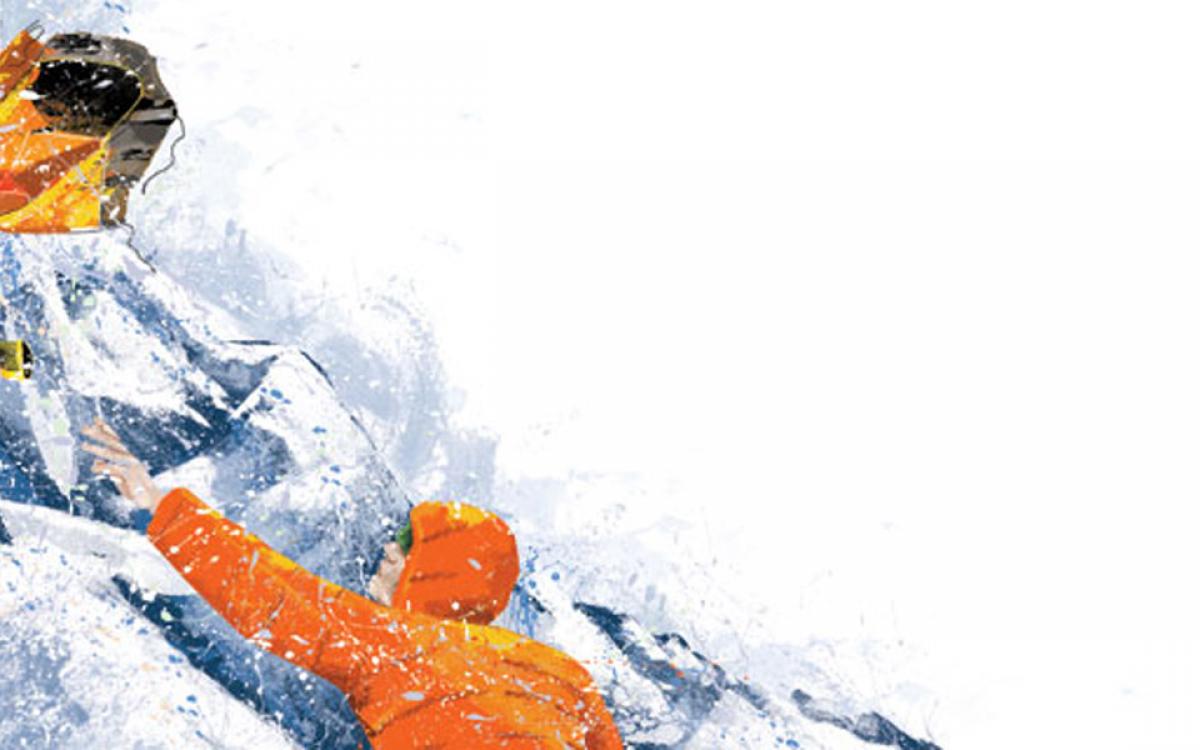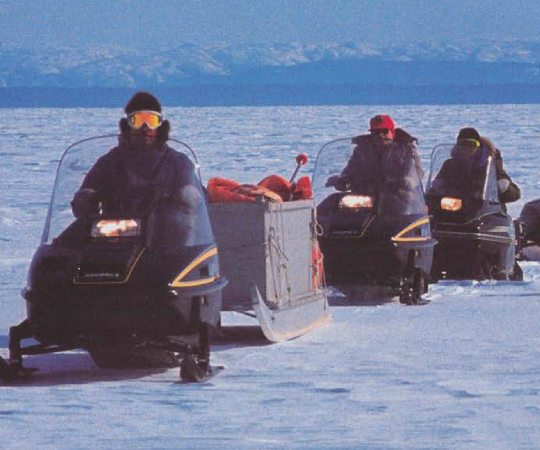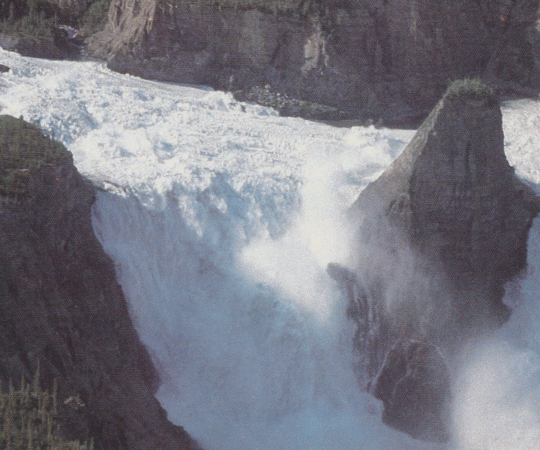Could you keep hope alive 100 feet down in a glacial crevasse? As you watch your supplies fly off the side of a mountain in a storm? As you plunge through the ice into frigid water?
Canada’s territories are populated by people whose bravery can match whatever danger is out there.
They first saw the subtropical cyclone as the dark clouds were still far away from Mount Logan. Erik Bjarnason and his climbing partners, standing on a ridge just below the mountain’s nearly 6,000-metre-high summit, figured they had about four hours to make it back to a safe camp. The closest one was only two hours away. They were in a hurry, but not panicked.
“Those clouds hit us within 15 minutes,” says Bjarnason. “It was the first time I’ve ever experienced something like that. It just moved so fast and it was so ferocious; beautiful blue sky, a warm nice day and then we’re on our hands and knees holding on for dear life.”
Pellets of ice shot straight at them and any exposed skin froze solid. Building a proper camp with wind barriers of snow would have taken hours in good weather and they didn’t have that luxury. “It’s like trying to put a tent on top of a van that’s going 140 kilometres an hour on a highway during a hailstorm,” says Bjarnason. “You know how to do it, but it’s just one of the most incredibly difficult things you’ll have to accomplish in your life.” But they got it set up.
When you’re 5,600 metres above sea-level on the side of Canada’s highest mountain, having all of your belongings secured isn’t just smart thinking: It’s the rule. It’s the reason the climbers’ backpacks were attached by carabineers to their tent poles, and why the structure was fixed to the ridge with ice screws.
They sat in there for one day and were out of water. Bjarnason, already feeling the delirium of hypothermia, took off his insulated over-mitts to light their camp stove and melt some water. He thought he could do it quick. Eight seconds.
But in that moment, a rogue gust of wind tore through the tent, ripped it away from the ice screws and pitched it straight into the air along with their bags. Bjarnason was dumped out the open door just before it disappeared over the ridge.
“We’re just watching as the tent basically leaves at a 70-degree angle straight up like an arrow,” Bjarnason says. “That was the most despairing thing. Everything we needed was in that tent and we’re watching it fly away.”
Within a few minutes, Bjarnason’s hands were frozen. He would be no help in building a snow cave—a sort of roofless igloo, with walls about four feet high and 2.5 feet wide. His fellow climbers Alex Snigurowicz and Don Jardine got to work immediately but realized most of the snow had been carried away by the wind. The best they could muster after six hours of intense labouring resembled a grave, but it was the best option at the time; it was a trench just large enough for the three men to lie in, one on top of the other. “This wasn’t plan A, B or C. This was somewhere around L,” says Bjarnason. “It was the longest period of my life.”
In the time it took to dig out the snow grave, Bjarnason clung to a rock with only thin liners and gloves protecting his hands. Frostbite can set in within 30 minutes at -30 C and they were seeing temperatures of 50-below—90-below with the windchill. “It’s like dipping your fingertips in boiling water and you can’t pull out. You’re slowly pushing your hands deeper and deeper in the water and after about eight or nine inches, there’s the other side of it: numbness … The numbness is so nice because there’s no pain but you know that there’s no pain because that part of your body is dead and will never come back.”
In those moments, Bjarnason questioned what sort of life he’d have without the use of his hands, if he survived. He’s a mountaineer, a firefighter, a search and rescue volunteer. All three of the men were members of North Shore Rescue in North Vancouver. Eight members of North Shore as well as one of their partners climbed Logan to mark the organization’s 40th anniversary. The group split off for different reasons—some had to leave earlier than others, some made the climb faster than others. Bjarnason and his companions were somewhere between the two larger groups.
For a day and a half, the three men lay in the snow grave—Bjarnason on the bottom. They could barely hear each other speak over the wind and as the hypothermia worsened, slurring words became grunts and moans. Help came first when climbers from the camp above made their way down, breaking trail through six feet of fresh snow for five hours. They brought a tent and small stove and set up camp to wait out the rescue. “It was unbelievable,” says Bjarnason. “It was such a sense of relief when I saw them. I thought we might have a chance.”
The crew at the lower camp got in touch with the Yukon Search and Rescue team based in Haines Junction. From there, the American military got involved, as well as the high-altitude helicopter contracted out for rescues on Mount McKinley. The climbers were rescued from Mount Logan on May 28—three days after the cyclone hit—and flown to the hospital in Anchorage, Alaska.
“Once they got to us, we were so hypothermic, I don’t remember a lot of that but then they were able to warm us up with hot drinks, Kool-Aid and gummy bears—oh my God they were so good, I hadn’t had food in so long,” he says. “Once they warmed me up, I was cognizant again and could understand what was going on and then it just seemed to take forever.” And the pain, Bjarnason says, as the numbness subsided and his hands began to thaw, was incredible. All eight of his fingertips were amputated along with half of his left thumb—not quite the loss he’d expected, and he was still alive.
With rehab, Bjarnason was able to return to work and to climbing. One year after Logan, he climbed Mount Elbrus in Russia; one of the Seven Summits (the highest mountain ranges in each continent—a sort of bucket list for mountaineers.) “It’s like being a drug addict: you know its going to hurt you, it costs you everything but you still do it,” he says. “What’s wrong with you?”
A day after we speak, Bjarnason launched Surviving Logan, a novel he co-wrote with Cathi Shaw. It took him back to a time when he was so sure he’d die that he gave directions over the radio as to where search parties would find their bodies, to tell his children he loved them. While he openly shares his near-death story, Bjarnason’s mother still struggles with it. Recognizing what his family went through while he was up on the mountain is one of hardest things he’s had to grapple with. It’s the reason, four years after the rescue, he turned back at around 6,000 metres while climbing Mount Everest, when altitude sickness set in. Because it wasn’t just about him, it was about those waiting for him at home. He wasn’t going to put them through another rescue.
For more from the In Need of A Hero feature, check out the February 2017 issue.









